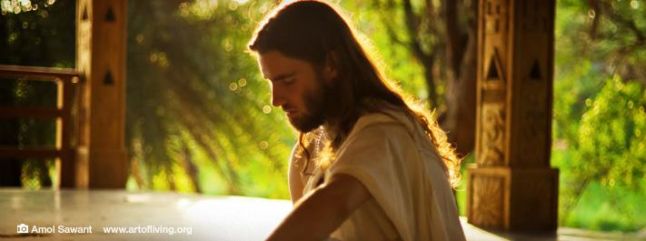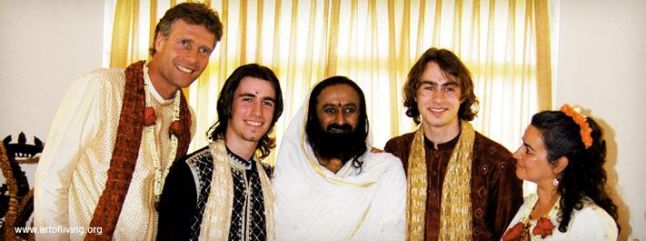Swami Purnachaitanya, ex-journalism graduate from Holland and now, travelling Art of Living teacher, has always been happy and fulfilled.
“I didn’t feel like getting a job or working to get a nice car or a house. I already felt good, so I thought why put more effort. Instead I could make myself useful to the world.”
Swami Purnachaitanya had his first taste of the Art of Living when he was 16.
“My mother had done the course and she invited me and my brother for a public program with Sri Sri (His Holiness Sri Sri Ravi Shankar)”
They were eager to go and six months later they did the Art EXCEL Course (that was then also meant for the age group of 13 to 18 years since the Youth Empowerment Seminar had not been designed yet) in the Netherlands.
What Swami Purnachaitanya also found fascinating was how the course helped them deal with what they wanted in life, what was troubling them, how they could be happy and how the mind works.
Sri Sri was a big inspiration for him.
“I first met him in the public talk in 2000 and I was very impressed. At that time, I didn’t know much about it. But I noticed his presence; he was so natural and so enthusiastic.”
Then he went on to do the first part of the Teachers Training Course just before starting university in 2004, completing it in 2008.
“I started teaching courses here in the International Centre in Bangalore. After that, I travelled a lot to parts of Karnataka, Tamil Nadu, Andhra Pradesh, Maharashtra, the North East, Sri Lanka and Dubai.
That’s where, he says, he really learnt what Indian culture was all about.
“I went to places where people might not know me, where I might not even speak their language. These people have not met me before and still they welcome me into their house with so much love and respect. They do so much to take care of their guests and these are people who, if you look from a Western mindset, have very little. They are even willing to share their last glass of water.”
Swami Purnachaitanya has been to villages, deep inside the North Cachar hills in Assam, known for its militant presence. What Swami Purnachaitanya learnt there was that these were not bad people, they just didn’t know how to solve their problems.
“We spoke to the local people and they asked us to help them set up projects: start schools, improve agriculture and conduct vocational trainings. There is no electricity, except from solar panels. There is hardly any agriculture. There is usually one vehicle going out of the hills to a nearby town, which people use to get supplies. It leaves in the morning and comes back by evening. So children can’t even go to school unless there is a school there. These people try very hard to solve their problems. It’s just that they don’t know how to go about it.”
These experiences taught him that human values of love and compassion are present in every human being and that stress is the root cause of violence.
“Even while teaching programs for prisoners in Manipur, they shared that what they did was not something they wanted to do. They simply got so stressed that they felt they had no choice.”
And Swami Purnachaitanya has dedicated his life to spreading the knowledge of a stress free-life, which he observes has become the need of the hour in the world today.
“People have not learnt how to manage their minds. They don’t know how to deal with their emotions, or to deal or the situations that life puts them in. And this knowledge has helped bring so much transformation all over the world.”
Swami Purnachaitanya is only further inspired by watching his guru connect with people across race, religion, class or every other stereotype.
“Personally, what really inspired me when I got to know Sri Sri was the way he is constantly working, sleeping only for a few hours a night and that for decades. At the same time, I see he is so free and totally aware every moment. He does not get annoyed or stressed. He does what is required at that time and place, for that person. It’s a miracle.”
He finds that this slowly happening in his own life.
“A while after I first began regularly practicing the pranayama and breathing techniques, I found that I was not getting stressed or angry anymore. I realized that very few things actually upset me and people began asking me how come I’m always smiling and enthusiastic."
He finds that the practices are now reflecting at many more levels.
“Today I travel so much, meet so many people in one day, stay in places where the food and climate is different. But when my practice is regular, I see that my body is able to quickly adjust to these changes so that there is hardly any stress. A few minutes of meditation and breathing brings in so much freshness and clarity.”
He also sees that he is now able to understand the nature of the mind much better.
“I’m able to understand more and more why I do what I do and how I respond to the environment. It’s like learning a language. And the more you understand how your mind works, the more you understand others because the laws of the mind are the same.”
What fascinated Swami Purnachaitanya about Eastern philosophy, therefore, is its relevance to life. Another aspect of Eastern philosophy that he has always been drawn to are the poojas and mantras. He now teaches the Sandhya Vandanam and performs the rudra pooja, which he learned in the ashram’s Veda Pathshala.
“I found that mantras had a profound effect on the state of my mind and I wanted to learn more. People are surprised that I have learnt it despite my origins. I think I was thirsting for it and it came naturally. It felt like I already knew it at some level. Wherever I go, people are impressed with the pronunciation.”
Though he is often asked why he is doing voluntary work in a faraway country instead of settling down, he feels that he wouldn’t want to be anywhere else.
“Sometimes people feel that the spiritual path is different from routine life, almost like spirituality is different from working or attending to the family. But for me being on this path means becoming more aware of life.”
The way Swami Purnachaitanya sees it, spirituality is anything that enlivens the spirit and brings up the human values of happiness, contentment and service. “It is also about asking oneself questions like why one is doing what one is doing, if that’s what one really wants and what is the purpose of life.”
“Whatever we do in life, if you really look into it, we basically do to become happy, contented, fulfilled. People spend their whole life running behind so many things, trying to achieve this. I have found this fulfillment in my life, and now I just want to share it with as many people as possible!”
If you like the story please write to us at webteam.india@artofliving.org
Writer: Harshini Vakkalanka, Graphics: Niladri Dutta




